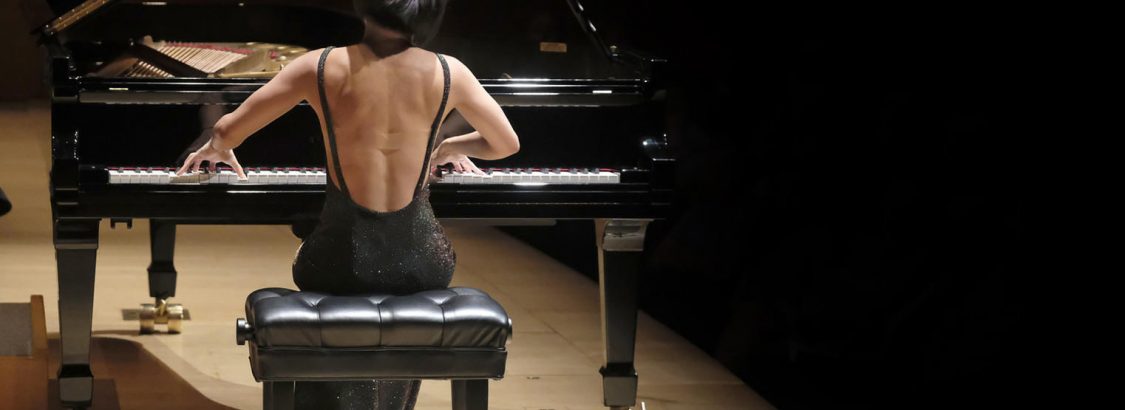Mark Swed, LATimes
Yuja Wang brilliantly completed her first cycle of the three Bartók piano concertos — the Second on Thursday and Friday; the Third on Saturday and Sunday — the latest step for the 30-year-old virtuoso on the path to possibly becoming one of the world’s most important pianists. Gustavo Dudamel surrounded the concertos with alluringly eerie accounts of Stravinsky’s “Symphonies of Wind Instruments” and spectacular ones of Janácek’s brassy Sinfonietta.
The orchestra’s season officially ends June 13 with a Green Umbrella Concert by its New Music Group in collaboration with the Industry staging Lou Harrison’s neglected opera “Young Caesar” (more confirmation of importance), but the main orchestra goes on break before returning to the Hollywood Bowl next month. Dudamel heads home to his beloved Simón Bolívar Symphony Orchestra of Venezuela. Wang heads off to turn heads wherever she goes and also to take on new challenges, such as trying her hand at conducting. There was joy in the Disney air from musicians who, by all appearances, have got the world on a string …
Wang’s Bartók cycle, her main project of the year, was all but derailed when Hungarian pianist and conductor Zoltán Kocsis died in November, ending her project of touring and recording the concertos with him. The L.A. cycle is now her first and, for the time being, her only …
But inside Disney, the mood was excitable, especially in the rapturous response Wang got from full houses that demanded encore after encore from her.
The 1931 Second Concerto contains what might technically be Bartók’s most impossible piano music and long thought best left to men. Hungarian pianist Edith Farnadi’s 1956 recording is, for instance, the only one I can find by a woman.
Coming onstage Thursday in a sparkly gown cut to her navel and designed especially for the concerto, as her regular atelier, Rosemarie Umetsu, notably does (Wang’s dress was as much of her persona that evening as Björk’s had been two nights earlier), the soloist obviously looked as feminine as she possibly could. She then attacked the concerto with a surfeit of unflappable virtuosic moxie and wattage few if any other pianists of any sex could match.
She treated the bravura of this busily intricate contrapuntal score with its volatile Hungarian rhythms as something she eats for breakfast. Her tempos were breakneck. My guess is she got all the notes, as if anyone cared.
With Dudamel’s full support, she displayed the kind of rhythmic propulsion and exuberance, gauging ebb and flow, that the best way to listen was to hop on for the thrill of the ride. The middle movement’s exotic night music duet between piano and percussion was less the exercise in mystery and menace that mortal pianists may seek and more the enchanting glitter of the starry sky.
Bartók’s Third Concerto, which I heard Saturday, is a world away. Written in 1945 as the Hungarian composer lay dying in New York, the score is a serene farewell intended for his pianist wife, Ditta Pásztory, to play. The slow movement contains Bartók’s most tender music and might be too heartbreaking to bear were it not for the chirping of birdsong.
To intolerant Bartókians, the Third Concerto is the weak one, verging on sentimentality. Wang would have nothing of that. She can be a flirtatious pianist when flippantly tossing off the most punishing passages, but sentimentality is seldom her problem. She strove, instead, for utter clarity as a device for warding off any trace of morbidity.
Bartók’s handwriting had gotten so weak that parts of his manuscript for this concerto are almost unreadable. Wang’s reading was that of an attempt to illuminate every one of a great composer’s last utterances, and was all the more moving for her cool elegance.
Dudamel and an exceptionally flexible L.A. Phil made much of what Wang wanted possible but not easy. That is to say that Dudamel never hesitated to cover the piano when the orchestral parts were particularly arresting. But at other times, interactions between piano and orchestral instruments, and particularly the percussion in the slow movements, were as touchingly intimate as chamber music.
Image: Francine Orr



